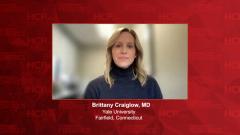
Overcoming Barriers in Accessing Care for Pediatric AD
Drs Brittany Craiglow and Angela Lamb provide insight on how they address access to care issues that arise for patients with pediatric AD.
Episodes in this series

Brittany Craiglow, MD: It’s great. We have some work to do. Especially for patients who have Medicaid or in underserved areas, access can be difficult. Is there any way specifically you address that?
Angela J. Lamb, MD: What we have tried to do, as you said, there are some better models of it in things like psoriasis. I know we’re talking about atopic dermatitis now, but for example you have that model where you have the e-consults or you do a multidisciplinary e-visit, where multiple physicians are going back and forth and we can give recommendations, and then also do technology-based checkpoints with patients. Doing outbound communication, asking them how they’re doing. In something like a chronic condition like atopic dermatitis, what happens is people contact me when they’re in a crisis. A season change, things like that, they’re in a crisis, they need an appointment tomorrow. Well, you’ve had atopic dermatitis for a while. Even children struggle, so we can perhaps do better outreach, which there are some good models for, depending on what technology system you have at your practice or your system, where you get ahead of it, everybody with this diagnosis gets an outbound message stating, “Do you have your refills? Are you ready?” That avoids some of that burden on physicians where we don’t feel like we have agency, we’re getting dumped on, people are coming to us right before an event, this is a holiday week, everybody wants everything before they leave for vacation. If we had been able to get ahead of that knowing that with atopic dermatitis, this is the time of year you’re flaring. There are some good models of that, I think, that improve access and minimizes physician burden, as well.
Brittany Craiglow, MD: I love that idea. You catch them before they fall. And it’s propping us up, too, because you’re preventing a lot of those things that happen when patients do fall—they lead to more time on the EMR [electronic medical records] trying to fit people in, busier clinics, etc. Maybe over time, one could imagine that those check-ins help the patients stay on top of their care better because it becomes more part of their routine. That is one thing about atopic dermatitis I remember when I was a resident thinking, gosh, why can’t people do what I’m asking them to do? And then I had my own kids, and I was like, wow. So I think, again, we have to work with the family to figure out, is this something that you can do? Is this reasonable? If you’re asking somebody to do something twice a day and the parents are up and out to work before the child wakes up, does the kid hate grease? Well, if so, then we probably shouldn’t be giving them an ointment. So meeting the family where they’re at is important, [as is] having them participate in the plan, because you can’t make some wild and crazy regimen and expect someone to do it if you couldn’t even do it yourself.
Angela J. Lamb, MD: The treatments are not always difficult. We’ll get to that in a bit. That’s what is so powerful about some of these newer medications that have come into the fold and, hopefully, we’ll have more indications for them for the pediatric community because slathering creams is not it anymore. Separate topic, but now we have things that are much more aligned with people’s lifestyles and how they live their lives.
Brittany Craiglow, MD: We accepted that because our options weren’t great before. I used medicines like cyclosporine and methotrexate when I had to. But having an option like dupilumab has made me realize I was undertreating a lot of people, even when I thought I was being aggressive. A lot of those patients in the middle who you felt like their AD isn’t bad enough to justify the blood draws and the talking about box warnings and all this stuff. You settle for this less-than-optimal option. One thing we need to do as a community and help pediatricians understand also is that it doesn’t have to be the way it used to be. Times are changing. This is a disease where now we can get most people to clear or almost clear, and largely in a safe way. That is something that takes a while. You get stuck in your ways, but a lot of the things that we used to ask people to do aren’t feasible for most families. There’s data that the average caregiver of a child with moderate to severe atopic dermatitis spends like 20 hours a week caring for their child. One of the things I say to parents is that when the child has it, you have it. They’re waking up at night. They’ve got grease on their clothes.
Angela J. Lamb, MD: That’s the whole thing. I have 3 children. My youngest one is 9 months. I can barely give him a bath.
Brittany Craiglow, MD: We’ve talked a lot about communication with pediatricians. Obviously, that’s important. In systems where everybody has a shared medical record, that’s useful. But when there aren’t, do you send letters, or how do you communicate with your referring doctors?
Angela J Lamb, MD: Mostly sending letters. It’s the old-fashioned way, sending letters, emails, texting, that’s it. Again, the EMR has been a game changer. I don’t do that as often anymore because we can communicate through the health care record.
Transcript edited for clarity
Newsletter
Access practical, evidence-based guidance to support better care for our youngest patients. Join our email list for the latest clinical updates.








